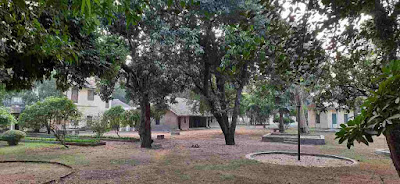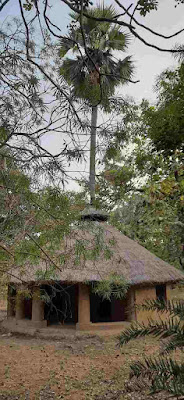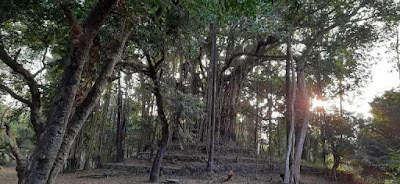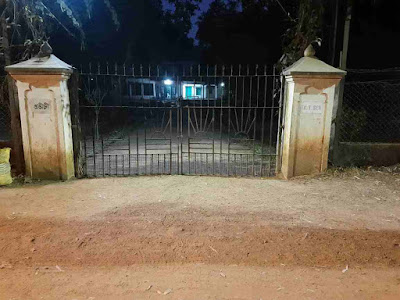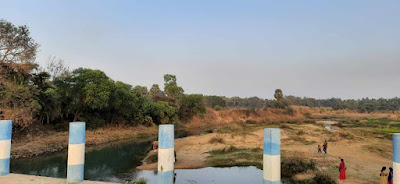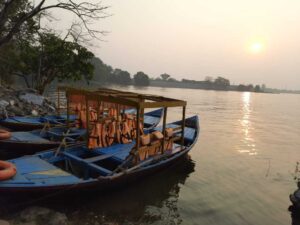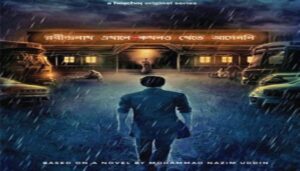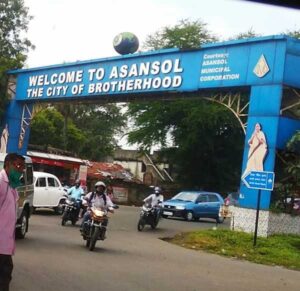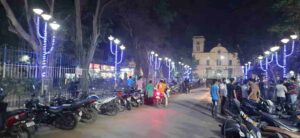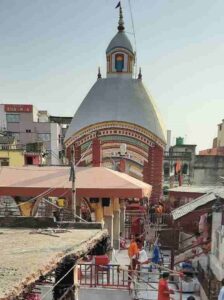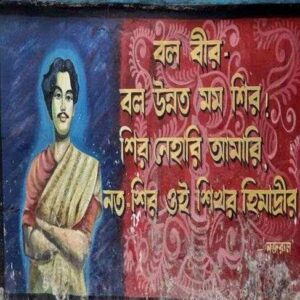Shantiniketan, situated approximately 100 miles from the north of Kolkata, is the favorite tourist place of Bengalis. Every corner of this place speaks of the memoirs of Rabindranath Tagore. The Nobel laureate penned many of his literary classics at this place. It comes under the municipal area of Bolpur that is part of the Birbhum district in West Bengal, India.
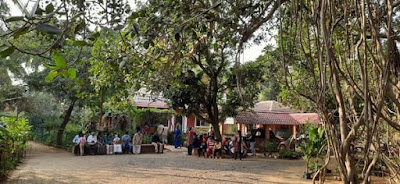 |
| Shantiniketan |
History Of Shantiniketan
In the book Rabindranath Tagore- A Biography, author Krishna Kripalani has written about the origin of Shantiniketan. Maharshi Devendranath Tagore, soon after the birth of his son, Rabindranath Tagore(Read his biography here), set out to visit the country estate of his friend. He proceeded in a palanquin.
In those days, the place was called Bhubandanga, named after the Zamindar of that area, Bhuban Mohan Sinha. The landlord was ready to gift the land to Maharshi. But Maharshi refused the grant and bought the 20 acres of land at nominal token money.
In 1873, When the poet was 12 years old, after his Upanayana(sacred thread) ceremony, his father took him for a vacation in the Himalayas. Their first halt was at Santiniketan. That was the first great adventure of his life and greatly influenced his spiritual and moral development.
Those days, Santiniketan was a barren land with broken soil, and there was a lack of adequate supply of water. The avenue of trees and groves of flowering bushes that features the present landscapes were not there. Still, young Tagore loved this freedom of space.
Later, rich soil was brought over from outside, and rows of various fruit trees and trees with extended foliage for shade were planted. Tagore visited many beautiful spots on earth, but this place remained his darling for life-long.
Visva Bharati University – World In One Nest
Rabindranath wanted to bring education reform in the country. He was not happy with the British education policy. It was preparing young men to become clerks in government offices. There was no place for science, creativity, and freedom.
His son, Rathindranath, was one of the first five students at the ashram. From 1925, the school became Patha Bhavana.
In 1921, Rabindranath Tagore founded Visva Bharati that became a central university in 1951. It is the only central university that has Prime Minister as its Chancellor.
Post-independence, Pandit Jawahar Lal Nehru became the first Chancellor of the university. Poet’s son, Rathindranath Tagore, was appointed the first vice-chancellor of Visva Bharati University.
Viswa Bharati offers courses from Nursery to Ph.D. . Patha Bhawan classes are held under the shade of trees. Degree classes are taught in the Bhawans. There are 25 hostels, 14 for girls and 11 for boys. Today Shantiniketan is also known as the University town.
The notable alumni of this institution include Amartya Sen, Indira Gandhi, Maharani Gayatri Devi, and many more.
It houses specialized institutes in different fields. Kala Bhavana is dedicated to visual and fine arts. Sangeet Bhavana is for music students with a specialization in classical and folk music.
Tagore wanted to bring the whole world in one nest. He aimed to make Visva Bharati an international center for research and study. There is a Cheena Bhavana that focuses on Chinese culture and traditions. One can learn Japanese arts and customs at Nippon Bhavan.
Bangladesh Bhavana was inaugurated in the year 2018. Bangladesh Government and the Visva Bharati started this cultural center and a museum to highlight the cultural ties between India and Bangladesh.
Maharshi Devendranath Tagore took initiation in Bramho Dharma on Wednesday. So, to remember that day, the university remains close on Wednesday.
Many tourist attractions also remain close on Wednesday and Thursday in Shantiniketan. The campus visiting time is 1 pm to 5 pm. On Wednesday, the campus is open since morning.
The Human Development Report for Birbhum,2009 suggests that annually 1.2 million tourists visit this place.
Places To Visit On The Shantiniketan University Campus
The University campus is around 3 Km from Bolpur Shantiniketan railway station.
Rabindra Bhavan
It is one of the first points of interest for anyone visiting Shantiniketan. Rathindranath Tagore founded this place in 1942, after the death of his father.
Numerous items associated with the poet’s life are kept at this museum. It houses his manuscripts, paintings and sketches, books, and journals, photographs.
The Nobel prizes are on display in the museum. The Nobel medal was stolen in the year 2004. The Swedish Academy, the body that organizes the annual honors, had provided the Vishwa Bharati Chancellor with a replacement medal made of gold and a replica made of bronze.
Shantiniketan Griha
When Tagore first visited Shantiniketan with his father, they stayed in this house. It is transformed into a museum. Famous sculptor Ramkinkar Baij had made the statue outside the home.
Chhatimtala
At this place, Maharshi Devendranath Tagore got the spiritual realization. It was under these trees, Gurudev started his Brahmacharya Ashram with five students. It is also the official tree of West Bengal. Even now, prayer services are held under the Chhatim trees on extra-special days.
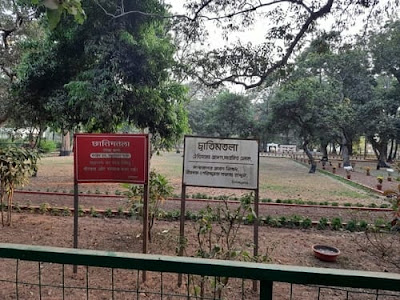 |
| Chhatimtala |
When Tagore Won the Nobel prize for Literature in 1913, Prominent personalities had come from Kolkata by train and felicitated him with a bangle made of Chhatim leaf. Since then, it has become a tradition that all passing out students are gifted a bangle having seven Chhatim leaves during the graduation ceremony.
Amrokunjo
The brahmacharya ashram came to be known as Patha Bhavana in 1925. Tagore visioned of schools where students will not be caged behind four walls. They will breathe in free air and learn. He believed that creativity and freedom are interlinked.
Uttarayana Complex
Tagore built five houses in the Uttarayan complex, Udayan, Shyamali, Konark, Udichi, and Punascha. Shyamali and Konark are mud houses. Kala Bhavana students have decorated the entire outside wall with beautiful relief work.
Mahatma Gandhi and Kasturba Gandhi stayed in the house during their visit. Important guests during their visit stayed at the grand Udayan.
Prayer Hall
It is a great attraction for tourists from all around. This place was also featured in the Bengali movie Posto.
Every Wednesday morning and on special days like Bengali new year, Rabindra Jayanti, etcetera, prayers are held here. People from any caste and creed could come and meditate on the one Supreme God.
Kalo Bari
Ratan Kuthi
Rathindra Atithi Griha
It is known for its state-of-the-art facilities. Important guests such as The President, Prime Minister, or foreign guests who visit the university here.
Sculptures By Ramkinkar Baij
Sinha Sadan
Satyendra Prasanna Sinha, the landlord from the Sinha family of Raipur, Birbhum, donated the building. There are a clock tower and bell that regulates the timings for the ashrama inmates. Oxford University conferred its honorary doctorate on the poet Rabindranath Tagore on this same building.
There is also a Ghontatola, where a big bell is there.
Taladhwaja
Teen Pahar
Tagore made these three hillocks of pebbles on his first visit to Shantiniketan. Hence the name, Teen Pahar. There is also an ancient banyan tree planted by Maharishi Devenedranath Tagore.
Tourist Attractions at Shantiniketan
Ballabhpur Wildlife Sanctuary
Ballabhpur Wildlife Sanctuary, located 3 km from Shantiniketan, is a famous Deer Park. Established in 1977, It is a large area with herds of deer and makes a natural bird sanctuary.
Gitanjali Rail Museum
The museum is located just outside the Shantiniketan railway station. It exhibits the railway Saloon Car that the ailing Tagore had undertaken on his last train journey from Bolpur station to Kolkata in July 1941. Numerous rare black & white photographs of the poet in various moods with his companions are there.
Amar Kutir
Tagore founded the ashram, Amar Kutir, meaning my cottage, for independence movement activists released from the colonial jails. Now, It houses a cooperative society for the promotion of village arts and crafts. About 15 kilometers from the central areas of Santiniketan, on the banks of the Kopai River. It offers leather goods, bamboo crafts, Kantha stitched saris, and batik at a fair price.
Srijani Shilpagram
It showcases the homes, lifestyle, handicrafts of the Eastern and North-Eastern states in India. This government took this initiative to help the rural artisans to sell their fabrics, handicrafts. The site is decorated with mud, bamboo, straw huts with beautiful murals on the walls.
Sonajhuri Haat
Every Saturday and Sunday, one can visit the haat (or market) at Sonajhuri, close to Shantiniketan. From this village market, one can buy local handicrafts and listen to folk music sung by tribal groups. It is a Khoai area affected by soil erosion.
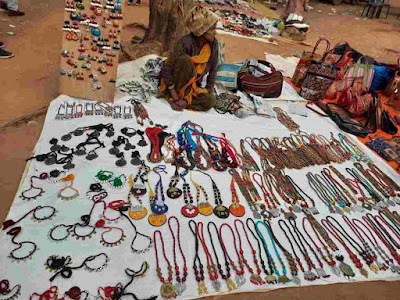 |
| Sonajhuri Haat Buy Here: Terracotta Handmade Necklace |
Amartya Sen’s House
Nobel laureate Amartya Sen was born here and studied at Shantiniketan. Gurudev gave Amartya Sen his name meaning immortal or heavenly. His maternal grandfather (Kshiti Mohan Sen) used to teach Sanskrit and ancient and medieval Indian culture and was a close associate of Rabindranath Tagore.
Surul Rajbari
Konkalitola Temple
This Shakti Peeth is situated on the bank of the Kopai River. It is believed that Goddess Sati’s bones have fallen here, hence the name, Konkalitola.
Salboni
Bengali movie Bela Sheshe and Posto movie shooting have taken place in this woods.
Kopai River
The rivers Kopai that flows past the town attract tourists. Gurudev wrote the famous Bengali rhyme for nursery kids based upon this river.
Boishak mashe tar hatu jol thake
Main Festivals At Shantiniketan
Poush Mela
Around 1500 stalls take part in the fair. Live performances of Bengali folk music such as baul, kirtan mesmerize the audiences. The magnificent performance of the Viswa Bharati students makes this festival more enjoyable and glamorous.
Basanta Utsav
Holi, the festival of colors and the arrival of spring, is celebrated in a different style. The program starts in the morning with singing and dancing to Tagore’s song ‘Ore Grihobaasi Khol, Dwaar Khol, Laaglo Je Dol’ by the students and ends with spreading colored powders (called Abir) and expressions of festive wishes.
Tagore himself started Dol Jatra and is a great tourist attraction.
Based on your budget, you can stay in a lodge, resort, or homestay. On weekends rates are high in hotels. Also, during Basanta Utsav and Poush Mela, hotel rates are higher than usual. Best way to visit the tourist places in the town by hiring E-rickshaw or Toto.

